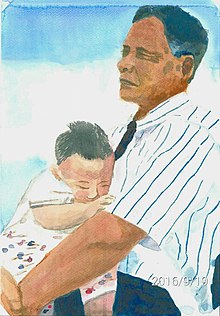Tiway Sayion

Tiway Sayion ( Chinese 帝 瓦伊 · 撒 耘, 李 來 旺 ; Japanese 木 原 武 一 ; * October 13, 1931 ; † September 24, 2003 ) was a primary school teacher in Hualien County and a member of the indigenous Taiwanese people of the Sakizaya . In his later years he devoted himself to the revival of the Sakizaya culture.
Life
After the Takobowan battle (or Takubuwan battle; in the Sakizaya language: Takubuwa a kawaw ; in Kavalan: Lanas na Kabalaen ; Chinese: 加 禮 宛 戰役) the Sakizaya fled from their Qing followers. Tiway Sayion's grandfather fled to what is now Ciwidiyan (Shuilian Village, 水 璉 村 , in the rural community of Shoufeng ) and eventually became the chief of Ciwidiyan. Like the other Sakizaya survivors, he hid under the Yanks and was registered as a member of the Yanks by the Japanese government (1895-1945).
Tiway Sayion was born in Ciwidiyan in 1931. His mother was an American. At the age of nine, he attended Ciwidiyan Elementary School (now Shui-Lien Elementary School) and was the last graduate of the school during the Japanese rule of Taiwan. At the age of twelve, Tiway Sayion adopted the Japanese name Takehi Kihara 木 原 武 一 as part of the policy of Japanization . Two years later, after the Republic of China took over Taiwan , the name was changed to the Chinese name Lee Lai-wang ( 李 來 旺 , Lǐláiwàng ). With his little knowledge of Min Nan and the Chinese characters acquired in Japanese lessons, he learned the Taiwanese Mandarin in an old temple . A year later he was admitted to the Hualien Teacher Training Seminar (now known as Dong Hwa National University ). After graduating, he taught in schools in the indigenous districts and, at the age of 27, moved back to his primary school in Ciwidiyan as head of the school. Until his retirement he worked in nine schools. Compared to his fellow students at the teacher training seminar, however, due to his indigenous identity, he was never able to teach in schools outside the indigenous districts.
In 1994 he applied for the name change of the primary school Tafalong according to the language of the Amis Tafalong , and this was approved. When he was the headmaster of Tafalong Elementary School, he published the first set of teaching materials for the American language using the Latin writing system. A year before his retirement, he officially changed his name to the indigenous name Tiway Sayion .
After retiring as headmaster, he taught at Tzu Chi University and devoted himself to the publication of the linguistic historical material of the Sakizaya. In 1999 he was named one of the most influential figures in Taiwan for the past 400 years by the Taiwanese magazine gewählt einer , Tiānxià zázhì ( CommonWealth Magazine ). In 2000 he was included in the BBC documentary series and was awarded the Taiwanese government's award for the social development of indigenous peoples .
In his later years he devoted himself to the task of reviving the Sakizaya ethnic group . In 2003 he died of a heart attack . Mainly because of his work to rebuild the culture of the Sakizaya, the Sakizaya were officially recognized by the Taiwanese government as an independent ethnic group on January 17, 2007.
Individual evidence
- ↑ 羅添斌: 加 禮 宛 事件 導致 隱 名 避禍. Liberty Times 《自由 時報》, January 17, 2007, accessed October 30, 2015 (Chinese (Taiwan)).
- ↑ 李光 真: 〈台灣 第 一位 原住民 校長 ── 李 來 旺〉. In: 《台灣 光華 雜誌》.台灣 光華 畫報 雜誌 社, January 2000, accessed October 30, 2015 (Chinese (Taiwan)).
- ↑ 專訪 實錄 : 李 來 旺 校長.後 山 原住民 文化, Retrieved October 30, 2015 (Chinese (Taiwan)).
- ↑ 專訪 實錄 : 李 來 旺 校長.後 山 原住民 文化, Retrieved October 30, 2015 (Chinese (Taiwan)).
- ↑ 鄭一青: 〈電廠 葬送 半壁江山?〉 . In:天下雜誌社(ed.): "天下雜誌" . 第 203 期 June 25, 2012 (Chinese (Taiwan), online ).
- ↑ 白 心儀 、 鍾德榮: 宋楚瑜 探視 樁 腳 李 來 旺 頻頻 拭淚. TVBS, July 26, 2003, accessed October 30, 2015 (Taiwanese Chinese).
- ↑ 林瑞珠: 〈縱 谷 傳奇 撒奇萊雅 重建 之 歌〉 . In: 行政院 原住民 族 委員會 (Ed.): 《原住民 族 季刊》 . 第 18 期, 2012 (Chinese (Taiwan)).
| personal data | |
|---|---|
| SURNAME | Sayion, Tiway |
| ALTERNATIVE NAMES | Lee Lai-wang; 李 來 旺 |
| BRIEF DESCRIPTION | Taiwanese ethno activist |
| DATE OF BIRTH | October 13, 1931 |
| DATE OF DEATH | September 24, 2003 |